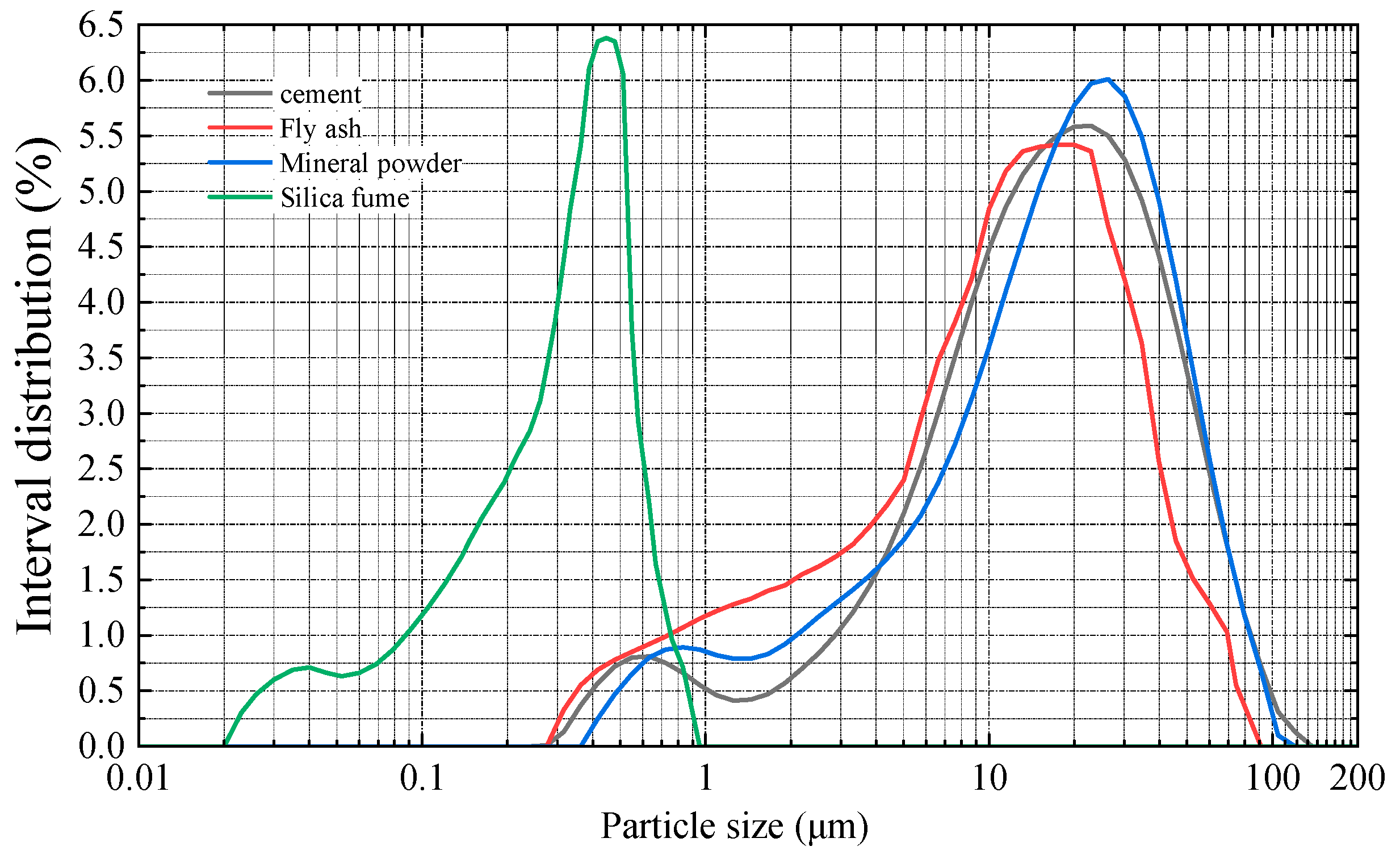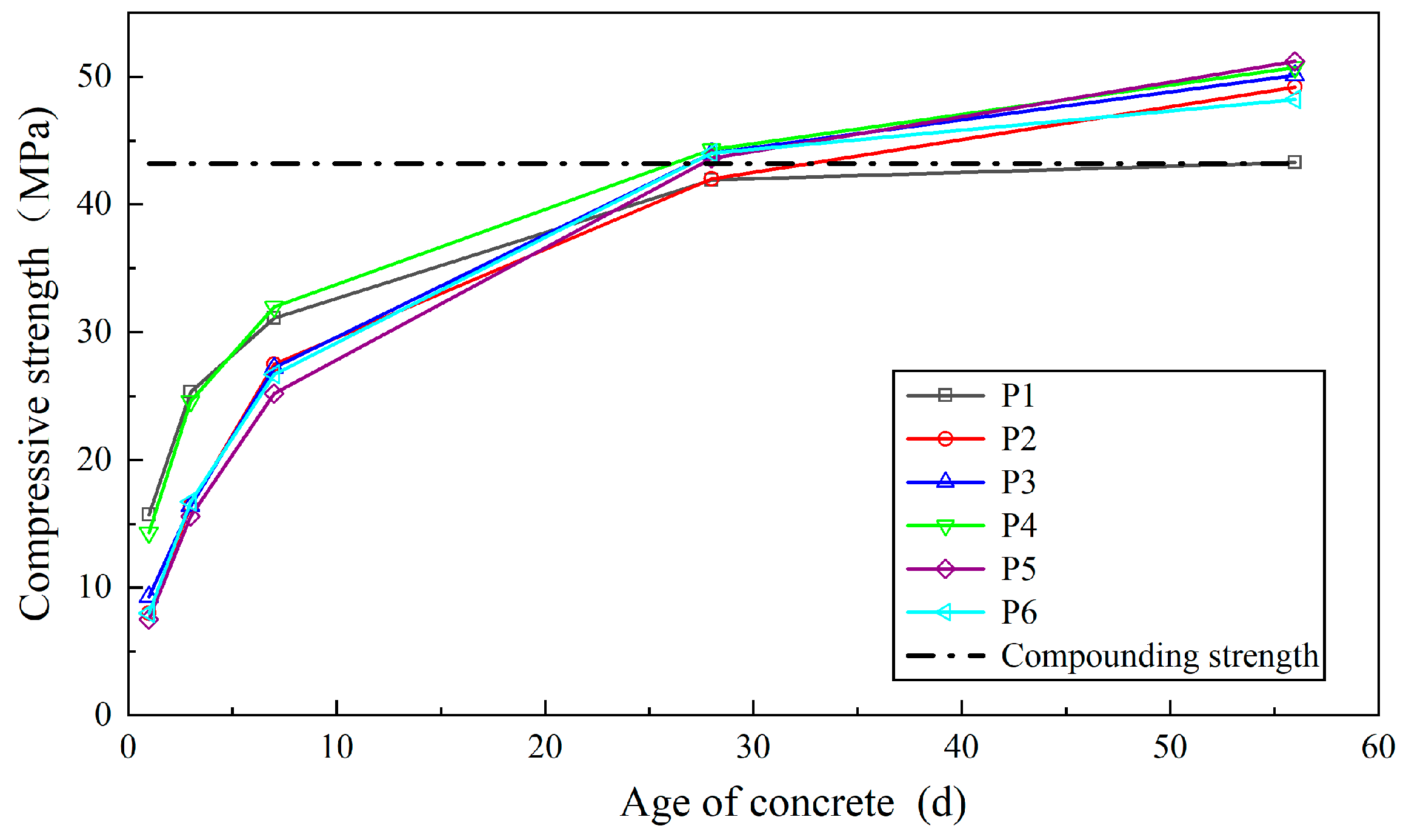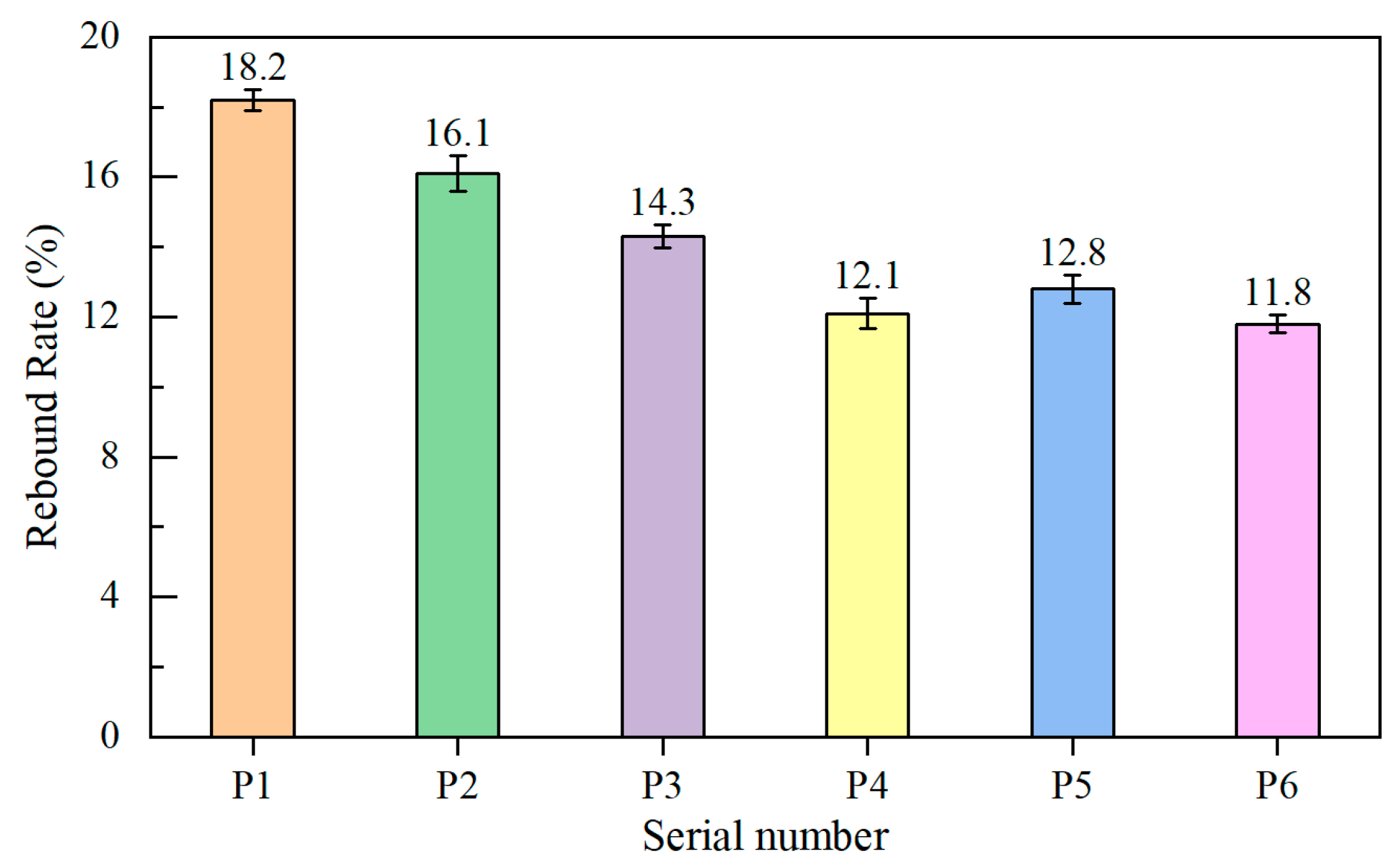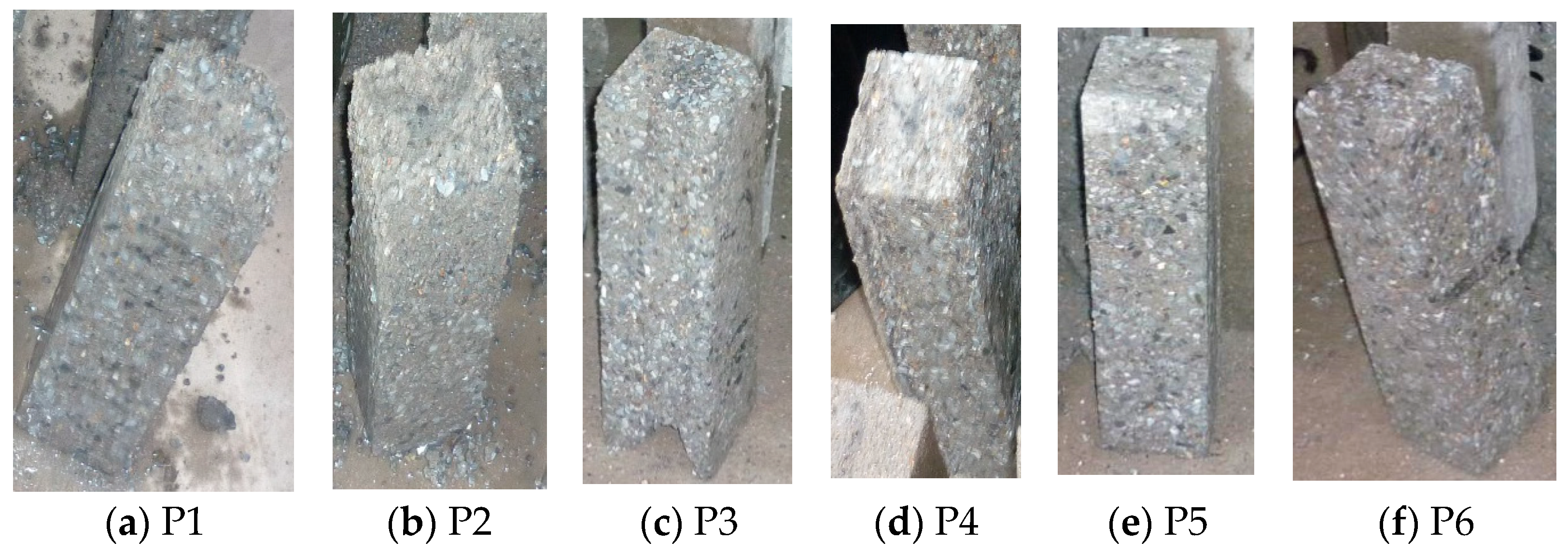1. Introduction
Most structural concretes within engineering show deterioration under complex and harsh environmental conditions [
1]. Maintaining normal functionality and achieving the designed service life often require substantial maintenance costs. Additionally, premature functional loss of concrete structures due to deterioration generates considerable construction waste, leading to significant social issues and environmental impacts. Enhancing the durability of concrete structures in complex and adverse conditions while reducing maintenance costs has become a major research focus for many scholars [
2,
3,
4,
5].
China has an extensive network of mountain tunnels subject to diverse environmental conditions, marked by “corrosion in the south and freeze–thaw deterioration in the north.” Tunnel composite lining systems comprise three components: surrounding rock, initial support (primary lining), and secondary lining, with concrete and steel as the primary materials for both linings. These components share similarities with conventional above-ground structures. However, their underground location and enclosure by surrounding strata, especially in cold and water-rich environments, make the concrete surfaces of structural elements vulnerable to loosening, peeling, aggregate exposure, and even reinforcement exposure during freeze–thaw cycles in early spring and winter, leading to durability issues that fall short of the designed service life [
6,
7,
8]. In-depth research on the deterioration mechanisms and patterns of concrete materials under cold environmental conditions is essential to provide a theoretical foundation for durability design [
9].
Kyle de Bruyn et al. [
10] investigated concrete durability under freeze–thaw conditions by measuring relative dynamic modulus and percentage weight loss. They found that air-entrained Portland cement concrete and CSA cement concrete exhibit similar relative dynamic modulus variations when using coarse aggregates with good freeze–thaw durability. Zhang et al. [
11] studied the durability of concrete with fly ash as fine aggregate under alternating freeze–thaw and carbonation conditions. They conducted freeze–thaw and carbonation cycle tests and developed a prediction model for neutralization depth, with freeze–thaw cycles and water–cement ratio as parameters. Zhang et al. [
12] conducted freeze–thaw tests on ultra-high-performance concrete with and without steel fibers. Results showed that steel fibers inhibit crack expansion, enhancing freeze–thaw resistance. Li et al. [
13] investigated the durability and micro-characteristics of blended cement concrete under marine corrosion and freeze–thaw conditions. Their tests revealed that concrete containing both fly ash and mineral powder exhibits better freeze–thaw resistance than concrete with only one of these materials. Yao et al. [
14] measured pore structure parameters and microstructures of concrete cured under standard and water-immersion conditions, followed by freeze–thaw tests. They found that standard-cured concrete suffered more severe damage than water-cured concrete. Wang et al. [
15] studied the impact of freeze–thaw cycles on the mechanical properties and chloride ion permeability of C30 concrete by measuring compressive strength and weight loss. They concluded that chloride ion concentration increases in freeze–thaw damaged concrete and proposed a model to predict chloride ion distribution under varying minimum freezing temperatures. Deng et al. [
16] conducted freeze–thaw cycle tests on various fiber-reinforced concretes in a Tibet Road project and developed a freeze–thaw damage model suitable for the Qinghai–Tibet Plateau region. Extensive research on concrete freeze–thaw durability has been conducted by domestic and international scholars. Studies have revealed deterioration patterns and developed freeze–thaw deterioration models based on tests involving various aggregates, cementitious materials, and fiber-reinforced concretes, offering a robust foundation for predicting concrete life in cold regions. Li [
17] et al. investigated the mechanical properties and deterioration patterns of recycled concrete subjected to combined freeze–thaw cycles and sulfate corrosion, establishing a life prediction model for recycled concrete under these conditions. Wu et al. [
18] conducted rapid freeze–thaw and mercury intrusion tests on concrete with four water–cement ratios, developing a freeze–thaw damage model for composite limestone powder–fly ash–slag powder concrete across various cementitious material systems. Xu et al. [
19] examined the effect of high stone powder dosage on the unconfined compressive strength of concrete through freeze–thaw cycles, compressive strength tests, and nonlinear ultrasonic analysis. They found that stone powder can partially replace cement, reducing its usage and offering valuable insights for the engineering application of high stone powder dosage concrete in cold regions. Li et al. [
20] investigated the freeze–thaw characteristics of coal gangue concrete with varying silica fume contents and water–cement ratios under low-temperature conditions. They developed a freeze–thaw damage model based on the relative dynamic elastic modulus and the integral pore area and proposed a durable coal gangue concrete mix ratio for low-temperature environments. Mahmoud Nili et al. [
21] developed a new model for concrete deterioration under freeze–thaw cycles through mathematical derivation and experimental verification, offering a framework for assessing concrete degradation in such conditions. Yang et al. [
22] conducted indoor coupling tests of fatigue loading and freeze–thaw actions, finding minimal impact of fatigue loading alone on concrete strength. However, under combined fatigue loading and freeze–thaw conditions, the concrete structure deteriorated significantly, strength decreased notably, and internal cracking developed rapidly. Extensive research has been conducted by domestic and international scholars on concrete freeze–thaw behavior. Studies have revealed various deterioration patterns and established freeze–thaw damage models based on tests of different aggregates, cementitious materials, and fiber-reinforced concrete, providing a solid foundation for the life prediction of concrete in cold regions.
Wet-sprayed concrete is widely used for the initial support of tunnels due to its faster setting speed and higher early compressive strength compared to ordinary concrete, effectively enhancing the stability of surrounding rock after excavation. As a result, numerous domestic and international studies have focused on the durability of wet-sprayed concrete in cold environments. Gao et al. [
23] summarized the pore structure model of wet-sprayed concrete, compared pore structure testing methods, and concluded that internal pore characteristics significantly influence frost damage. Zhao et al. [
24] reviewed research on frost damage and freeze–thaw resistance of wet-sprayed concrete in cold-region tunnels, highlighting that air-entraining agents or steel fibers enhance freeze–thaw durability. Chen et al. [
25] performed macro tests on ordinary wet-sprayed concrete and concrete with air-entraining agents, confirming that air-entraining agents improve freeze–thaw durability. Kael et al. [
26] found through standard freeze–thaw tests that wet-sprayed concrete with ethylene-vinyl acetate copolymer film waterproofing resists freeze–thaw damage under tested hot and humid conditions. Zhang et al. [
27] compared the freeze–thaw resistance of high-performance wet-sprayed concrete, cast-in-place concrete with an accelerator, and ordinary wet-sprayed concrete. They found that ordinary wet-sprayed concrete experiences the greatest strength loss under freeze–thaw cycles, followed by cast-in-place concrete with an accelerator, while high-performance wet-sprayed concrete shows the least strength loss. Wang et al. [
28] employed solid–liquid extraction and electrochemical methods to measure the pH and NO
3− content of wet-sprayed concrete under nitric acid erosion and freeze–thaw cycles. They observed that the concrete suffers from the combined effects of H
+, NO
3−, and freeze–thaw damage, causing rapid surface erosion, a loose structure, and severe physical and mechanical degradation. Sun et al. [
29] conducted mass loss and uniaxial compressive tests on C20 and C25 coal gangue wet-sprayed concrete under varying freeze–thaw cycles. They concluded that C25 coal gangue concrete has superior freeze–thaw resistance compared to C20. In summary, extensive research has been conducted on the durability of wet-sprayed concrete in tunnel initial support under freeze–thaw cycles. However, systematic studies on freeze–thaw deterioration patterns and service life prediction models for wet-sprayed concrete with composite cementitious materials containing various mineral admixtures remain insufficient.
The extent of freeze–thaw damage in concrete depends on environmental conditions, concrete compactness, saturation level, and the number of freeze–thaw cycles. The complexity of concrete freeze–thaw damage, combined with the relative lag in the interaction of the initial support behind the secondary lining with the tunnel environment, has limited research on the deterioration patterns of freeze–thaw effects on initial support wet-sprayed concrete. This study develops low-rebound, high-density tunnel wet-sprayed concrete by analyzing the micromorphology and particle size distribution of cementitious materials to improve its mechanical and durability performance. The study also examines the deterioration patterns of wet-sprayed concrete under freeze–thaw cycles with various cementitious material formulations and derives a freeze–thaw deterioration equation based on damage mechanics principles. Finally, the relationship between the damage modulus of wet-sprayed concrete and the number of freeze–thaw cycles is fitted to establish a service life prediction model for wet-sprayed concrete under freeze–thaw conditions, offering a scientific basis for predicting its service life in tunnel initial support.
Proportional blending of various powdered materials enhances the compactness of concrete.
Concrete with mineral admixtures exhibits lower early-age strength but higher long-term strength.
Concrete with mineral admixtures has a lower rebound rate and reduced dust content.
The incorporation of mineral admixtures enhances the freeze–thaw resistance of concrete.
A significant correlation was established between the compactness and frost resistance of concrete.
A predictive model for the durability of wet-mix shotcrete in cold regions was developed.
5. Durability Prediction of Wet-Sprayed Concrete in Cold-Region Tunnels
The critical challenge in predicting the durability of wet-sprayed concrete in cold-region tunnels lies in establishing the correlation between the freeze–thaw cycles experienced by the initial support wet-sprayed concrete under natural environmental conditions and those under indoor rapid freeze–thaw conditions while maintaining the same relative dynamic elastic modulus damage.
As per the specifications, the freeze–thaw test concludes when the relative dynamic elastic modulus falls below 60%, marking the end of the concrete’s durability life. Using the previously established prediction model, the durability life of concrete under freeze–thaw conditions can be determined.
Li et al. [
36] investigated the correlation between indoor freeze–thaw cycles and outdoor natural freeze–thaw cycles for concrete across various regions of China. They derived a formula for predicting the service life of concrete, presented in Equation (13).
where
T represents the service life of the concrete structure;
α is the freeze–thaw test conversion coefficient, which indicates the number of natural freeze–thaw cycles equivalent to one rapid indoor freeze–thaw cycle, with an average value generally taken as 12;
N is the number of rapid indoor freeze–thaw cycles when the relative dynamic elastic modulus is 0.6;
M is the number of freeze–thaw cycles experienced by the concrete structure in one year under natural environmental conditions. The statistical results of the average annual freeze–thaw cycles in cold regions of China are shown in
Table 8 [
37].
The ultimate number of freeze–thaw cycles for wet-sprayed concrete with various binder formulations can be determined using the freeze–thaw deterioration equation. The corresponding service life (in years) can then be calculated using Equation (13), as presented in
Table 9.
As shown in
Table 9, in the North China region, wet-sprayed concrete with single silica fume addition, double admixture, or triple admixture exhibits frost resistance durability exceeding 100 years. In contrast, concrete made with pure cement, single fly ash addition, or single slag powder addition demonstrates durability below 100 years. In the Northeast and Northwest regions, only wet-sprayed concrete with double or triple mineral admixture additions achieves frost resistance durability exceeding 100 years, while other formulations fall below this threshold. Across all cold regions, concrete with triple mineral admixture additions (fly ash, slag powder, and silica fume) exhibits the best frost resistance durability. However, the improvement over double additions of fly ash and slag powder is relatively marginal. Pure cement wet-sprayed concrete has the shortest durability. This is primarily due to silica fume’s extremely high fineness and superior viscosity, followed by slag powder, and finally fly ash. When appropriately proportioned, fly ash, slag powder, and silica fume fill voids between cement particles and between the cement paste and aggregate. They also complement each other, producing a “composite superposition effect” and creating a dense packing system. The addition of multiple mineral admixtures reduces internal porosity, resulting in denser concrete. Freeze–thaw damage progresses from the surface inward, thereby enhancing frost resistance.
The enhanced frost resistance and extended durability of concrete with mineral admixtures result from the promotion of secondary cement hydration, which increases compactness and lowers the permeability coefficient. This reduces moisture ingress under freeze–thaw conditions, further improving frost resistance. To enhance the frost resistance of wet-sprayed concrete, incorporating multiple mineral admixtures and strictly controlling the air content in fresh concrete is essential.
6. Conclusions
This study analyzed the micro-morphology and particle size distribution of powder materials and evaluated the rebound rate, mechanical properties, and durability of wet-sprayed concrete with varying components and dosages of composite binders, emphasizing frost resistance under freeze–thaw cycles. A freeze–thaw deterioration equation was developed based on damage mechanics theory to predict the durability of initial support wet-sprayed concrete in tunnels across different regions. The main conclusions are summarized as follows:
(1) The particle sizes and grading distributions of powdered materials vary. Proportional blending of these materials can produce a composite binder with continuous micro-grading and uniformity, significantly enhancing concrete compactness.
(2) Wet-sprayed concrete with single, double, or triple additions of mineral admixtures generally exhibits low early strength. Increasing admixture dosage reduces early compressive strength significantly but enhances later strength. Concrete with single silica fume addition shows excellent compressive strength at all ages.
(3) When appropriately proportioned, fly ash, slag powder, and silica fume fill the voids between solid particles. This effect, known as the “composite superposition effect,” creates a densely packed system that significantly improves concrete density. Additionally, slag powder and silica fume increase the viscosity, effectively reducing the rebound rate and dust content.
(4) The addition of multiple mineral admixtures promotes secondary hydration of cement, reduces the porosity of wet-sprayed concrete, and enhances both strength and compactness while lowering the permeability coefficient. Under freeze–thaw conditions, external moisture has difficulty penetrating the concrete, leading to significantly improved frost resistance compared to pure cement specimens.
(5) The relative dynamic elastic modulus of wet-sprayed concrete decreases with the number of freeze–thaw cycles, following a parabolic trend. The correlation coefficients of the fitted deterioration equations are all above 0.88, making them suitable for predicting the durability of wet-sprayed concrete in cold-region tunnels.
The prediction model developed in this study is based on the effects of freeze–thaw cycles on concrete, considering the types and dosages of mineral admixtures. However, due to the limited number of experimental samples, further extensive experiments are needed to refine the model for more accurate predictions that better reflect actual conditions in tunnels. Moreover, in this study, only the powder materials were characterized using Scanning Electron Microscopy (SEM). Future research should include microscopic analyses of the hardened concrete to assess its microstructural features and evaluate its quality from a microscopic standpoint.
















